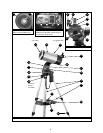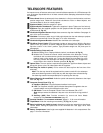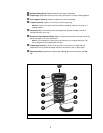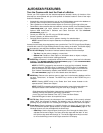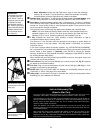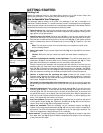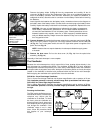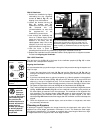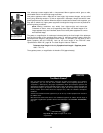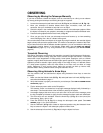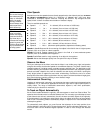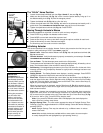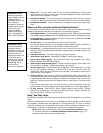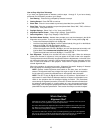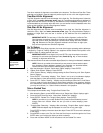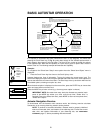
Your telescope comes supplied with a low-powered 26mm eyepiece which gives a wide,
comfortable field of view with high image resolution.
Low power eyepieces offer a wide field of view, bright, high-contrast images, and eye relief
during long observing sessions. To find an object with a telescope, always start with a lower
power eyepiece such as a 26mm. When the object is located and centered in the eyepiece, you
may wish to switch to a higher power eyepiece to enlarge the image as much as practical for
prevailing seeing conditions.
NOTE: Viewing conditions vary widely from night-to-night and site-to-site.
Turbulence in the air, even on an apparently clear night, can distort images. If an
image appears fuzzy and ill-defined, back off to a lower power eyepiece for a more
well-resolved image.
The power, or magnification of a telescope is determined by the focal length of the telescope
and the focal length of the eyepiece being used. To calculate eyepiece power, divide the
telescope's focal length by the eyepiece's focal length. For example, you may wish to use a
26mm eyepiece with the DSX-125. Look up the focal length of the DSX-125 under
"Specifications: DSX-125," page 39. The focal length is listed as 1900mm.
Telescope focal length divided by Eyepiece focal length = Eyepiece power
1900 Ö 26 = 73
The eyepiece power, or magnification is therefore 73X (approximately).
DSX TIPS
14
Fig. 14: Location of
telescope eyepiece.
Fig. 15a & 15b: Jupiter; example of too much
magnification.
Too Much Power?
Can you ever have too much power? If the type of power you’re referring to is eyepiece
magnification, yes, you can! The most common mistake of the beginning observer is to
“overpower” a telescope by using high magnifications which the telescope’s aperture and
atmospheric conditions cannot reasonably support. Keep in mind that a smaller, but bright and
well-resolved image is far superior to one that is larger, but dim and poorly resolved (see
below). Powers above 200X should be employed only under the steadiest atmospheric
conditions.
Autostar can calculate the best eyepiece for you to use. Try out the “Eyepiece Calc” feature in
the Utilities menu.
Most observers should have three or four additional eyepieces to achieve the full range of
reasonable magnifications possible with the DSX telescopes. See OPTIONAL ACCESSORIES,
page 37.



